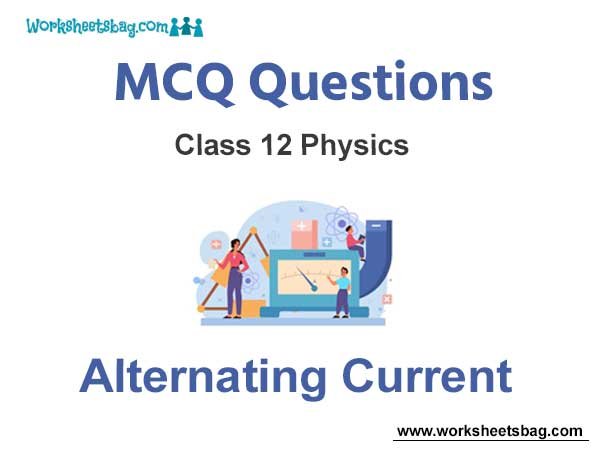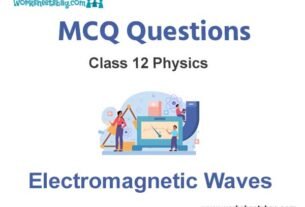Please refer to Alternating Current MCQ Questions Class 12 Physics below. These MCQ questions for Class 12 Physics with answers have been designed as per the latest NCERT, CBSE books, and syllabus issued for the current academic year. These objective questions for Alternating Current will help you to prepare for the exams and get more marks.
Alternating Current MCQ Questions Class 12 Physics
Please see solved MCQ Questions for Alternating Current in Class 12 Physics. All questions and answers have been prepared by expert faculty of standard 12 based on the latest examination guidelines.
MCQ Questions Class 12 Physics Alternating Current
Question. The rms value of potential difference V shown in the figure is

Answer
C
Question. The phase relationship between current and voltage in a pure resistive circuit is best represented by


Answer
B
Question. Alternating voltage (V) is represented by the equation
(a) V(t) = Vm e wt
(b) V(t) = Vm sin wt
(c) V(t) = Vm cot wt
(d) V(t) = Vm tan wt
Answer
B
Question. Which of the following graphs represents the correct variation of inductive reactance XL with frequency u?

Answer
B
Question. In a pure capacitive circuit if the frequency of ac source is doubled, then its capacitive reactance will be
(a) remains same
(b) doubled
(c) halved
(d) zero
Answer
C
Question. In the case of an inductor
(a) voltage lags the current by π/2
(b) voltage leads the current by π/2
(c) voltage leads the current by π/3
(d) voltage leads the current by π/4
Answer
B
Question. Which of the following graphs represents the correct variation of capacitive reactance XC with frequency u?

Answer
C
Question. At resonant frequency the current amplitude in series LCR circuit is
(a) maximum
(b) minimum
(c) zero
(d) infinity
Answer
A
Question. In which of the following circuits the maximum power dissipation is observed?
(a) Pure capacitive circuit
(b) Pure inductive circuit
(c) Pure resistive circuit
(d) None of these
Answer
C
Question. In series LCR circuit, the phase angle between supply voltage and current is

Answer
A
Question. In an alternating current circuit consisting of elements in series, the current increases on increasing the frequency of supply. Which of the following elements are likely to constitute the circuit?
(a) Only resistor
(b) Resistor and inductor
(c) Resistor and capacitor
(d) Only inductor
Answer
C
Question. In a series LCR circuit the voltage across an inductor, capacitor and resistor are 20 V, 20 V and 40 V respectively. The phase difference between the applied voltage and the current in the circuit is
(a) 30°
(b) 45°
(c) 60°
(d) 0°
Answer
D
Question. At resonance frequency the impedance in series
LCR circuit is
(a) maximum
(b) minimum
(c) zero
(d) infinity
Answer
B
Question. Quality factor and power factor both have the dimensions of
(a) time
(b) frequency
(c) work
(d) angle
Answer
D
Question. A transformer works on the principle of
(a) self induction
(b) electrical inertia
(c) mutual induction
(d) magnetic effect of the electrical current
Answer
C
Question. For an ideal-step-down transformer, the quantity which is constant for both the coils is
(a) current in the coils
(b) voltage across the coils
(c) resistance of coils
(d) power in the coils
Answer
D
Question. The natural frequency (w0) of oscillations in LC circuit is given by

Answer
C
Read the two statements Assertion (A) and Reason (R) carefully to mark the correct option out of the options given below:
(a) Assertion and Reason both are correct statements and Reason is correct explanation for Assertion.
(b) Assertion and Reason both are correct statements but Reason is not correct explanation for Assertion.
(c) Assertion is correct statement but Reason is wrong statement.
(d) Assertion is wrong statement but Reason is correct statement.
Question. Assertion: The alternating current lags behind the emf by a phase angle of π/2, when A.C. flows through an inductor.
Reason: The inductive reactance increases as the frequency of A.C. source decreases.
Answer
C
Question. Assertion: When capacitive reactance is smaller than the inductive reactance in LCR series circuit, emf leads the current.
Reason: The phase angle is the angle between the alternating emf and alternating current of the circuit.
Answer
B
Question. Assertion: Long distance transmission of A.C. is carried out at extremely high voltage.
Reason: For large distance, voltage has to be large.
Answer
C
Question. Assertion: A transformer cannot work on D.C. supply.
Reason: D.C. changes neither in magnitude nor in direction.
Answer
A
Question. Assertion: Soft iron is used as a core of transformer.
Reason: Area of hysteresis loop for soft iron is small.
Answer
A
Question. Assertion: We use thick wire in the secondary coil of a step down transformer to reduce the production of heat.
Reason: When the plane of the armature is parallel to the line of force of magnetic field, the magnitude of induced emf is maximum.
Answer
B
Question. Assertion: An alternating current shows magnetic effect.
Reason: Magnitude of alternating current varies with time.
Answer
B
Question. Assertion: A bulb connected in series with a solenoid is connected to A.C. source. If a soft iron core is introduced in the solenoid, the bulb will glow brighter.
Reason: On introducing soft iron core in the solenoid, the inductance decreases.
Answer
D
Question. Assertion: Capacitor serves as a block for D.C. and offers an easy path to A.C.
Reason: Capacitive reactance is inversely proportional to frequency.
Answer
A
Question. Assertion: At resonance, LCR series circuit have a maximum current.
Reason: At resonance, in LCR series circuit, the current and emf are in phase with each other.
Answer
B


